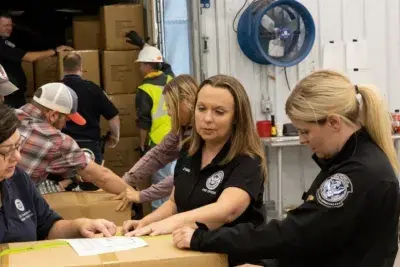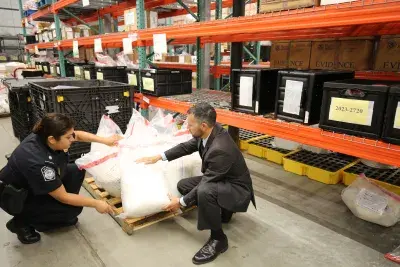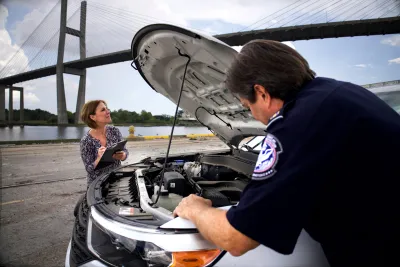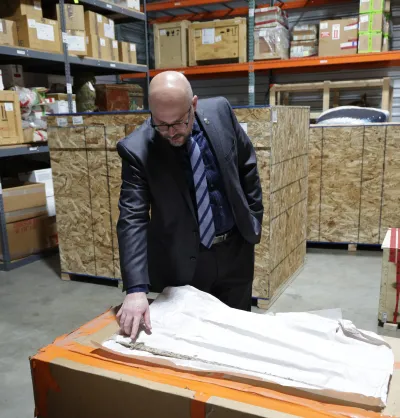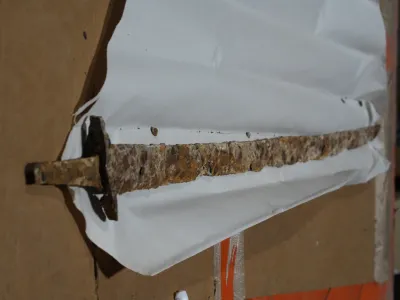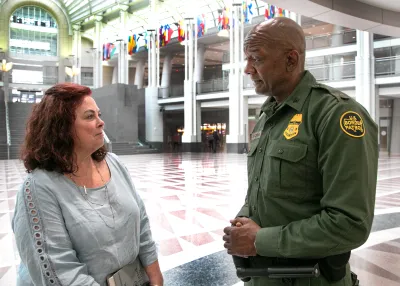
The Quiet Enforcers
Fines, Penalties, and Forfeitures Officer DeAnn O’Hara, second from right, inspects cargo with other CBP Field Operations colleagues to find prohibited items and counterfeit goods during a special rail operation on the northern border in International Falls, Minn. Although little-known, CBP’s Fines, Penalties, and Forfeitures Division works behind the scenes on nearly every enforcement action that CBP and its sister agency, HSI, takes. Photo by Charles Csavossy
The shipments of lighting fixtures were like other cargo transiting by rail from Canada into the United States. The merchandise was manufactured in China, shipped to a port in British Columbia, and entered the U.S. at International Falls, Minnesota, the busiest rail port in the country with over 622,000 sea containers processed each year. There, U.S Customs and Border Protection (CBP) officers inspected the shipments and determined that the lighting fixtures, imported by a U.S. home design company, bore counterfeit Underwriters Laboratories’ certification marks, and were deemed to be unsafe. The officers seized over 7,800 lighting fixtures from two shipments and handed them over to CBP’s Fines, Penalties, and Forfeitures Division to complete the enforcement action.
“Aside from seizing and destroying the fixtures, we fined this company,” said DeAnn O’Hara, CBP’s Fines, Penalties, and Forfeitures Officer for the area port of Pembina, North Dakota. “We issued a penalty of $50,000 on each of the shipments.”
“When U.S. consumers purchase a lighting fixture with a UL trademark on it, they are under the impression that the lighting fixture has been tested for safety. When Chinese manufacturers fraudulently place a UL trademark on untested fixtures, they are tricking consumers into buying a product that may not be safe and could start a fire in their homes. At CBP, we take the safety of the American public very seriously. That’s why we work so hard to remove unsafe products from the U.S. commerce before they can ever reach consumers.”
Outside of the trade realm, few know much, if anything, about U.S. Customs and Border Protection’s Fines, Penalties, and Forfeitures Division, also known as FP&F. Yet this powerful entity that writes policy for legal violations holds sway behind the scenes of nearly every enforcement action taken by CBP and its sister agency, Homeland Security Investigations (HSI).
Every seizure that a port of entry makes is adjudicated by FP&F. The same is true for cases that involve penalties or liquidated damages, which are issued when contracts are breached. FP&F also adjudicates seizures made by HSI. In doing so, the agencies work with the same guidelines to make sure they are properly forfeiting and disposing assets.
Housed within CBP’s Office of Field Operations, FP&F supports enforcement actions made by CBP and HSI. The division is responsible for the back-end work that protects the government’s revenue as well as the storage and destruction of narcotics and other potentially harmful illicit goods. But FP&F also has an obligation to provide the public due process. After goods are seized or a violation is found, the FP&F team comprised of 519 FP&F officers, paralegals, seized property specialists, and technicians nationwide, follows a strict process with timeframes to ensure that enforcement actions are fair to the public.
The work of FP&F dates to 1789 with the creation of the U.S. Customs Service, one of CBP’s legacy agencies. “At that time, there were no seized property specialists; customs collectors took care of seized property,” said Lisa Santana Fox, the Director of CBP’s Fines, Penalties, and Forfeitures Division. “Over time, the discipline developed because frontline officers needed to do their primary mission of stopping dangerous people and things from entering the country.”
Lawful seizures
FP&F’s involvement is triggered the moment an item is seized. “More than 50% of our cases are seizures,” said Reggie Rankin, the Fines, Penalties, and Forfeitures Officer for CBP’s Los Angeles Field Office. “When property is seized, the first thing that FP&F does is a legal sufficiency review. Our paralegals make sure that the property was taken legally. They look at the violations of law and make sure that they are accurate. FP&F’s job, at this stage, is to make sure that this is a legally sound and sufficient case. We don’t want the government taking property unlawfully.”
“After a legal sufficiency review, we do what’s called the forfeiture process,” said Rankin. “Depending on the type of property, it will go through a series of steps in which a paralegal specialist notifies parties of interest that their property was taken by the federal government.” The notice will explain the violation and the violator’s rights and options. Typically, the violator has 60 days to respond. Violators can abandon the goods, ask for an administrative review, or request a judicial forfeiture, which then goes to court.
As part of the administrative review, violators can file a petition. “Those petitions are reviewed by our paralegals who decide on the response. ‘Do we mitigate it? Do we give the property back? What are we going to do?’ And then there is an opportunity for violators to submit a supplemental petition. That petition comes to headquarters for review,” said Santana Fox. “So, there is a second layer of review before we forfeit someone’s property.”
The time range of reviews depends on the type of case. “Drug cases move very fast because illegal narcotics are prohibited. We want them out of our vaults as quickly as possible, typically within 30 days,” said Santana Fox. “Intellectual property rights cases can take longer. We try to adjudicate them within 90 to 180 days, but it depends on the complexity of the case. Fraud cases, where we issue a penalty, can take up to 20 years.”
“When officers and agents find violative goods, depending on what the goods are, we handle them differently,” said Santana Fox. “Drugs, firearms, and currency are considered high-risk property and we maintain custody of those items at all times. They go into a permanent seizure vault that is operated by CBP and we maintain control of them until disposal. DEA Schedule I and II drugs that have a high potential for abuse such as heroin, LSD, fentanyl, cocaine, and other illegal narcotics are automatically forfeited, which means the ownership is transferred to the government and they are destroyed as quickly as possible.”
Drug destruction
At the area ports in Los Angeles, illegal narcotics are set up for immediate destruction. “Every month we’re looking at thousands of pounds of hard and soft narcotics that go straight to the incinerator and get burned with the trash,” said Rankin “We have a very detailed-oriented process, which involves at least 25 armed officers and special teams.”
Approximately 65,000 pounds of narcotics are seized and destroyed at the Los Angeles area ports during an average fiscal year. “In July alone, we destroyed 8,500 pounds of fentanyl and precursor chemicals that were seized at Los Angeles International Airport," said Jacqueline Castillo, Chief Seized Property Specialist at CBP’s Los Angeles Field Office. Precursor chemicals are the ingredients used to create fentanyl and other narcotics.
“We’re dealing with a lot of dangerous things that could harm the American public and we’re trying to make sure they remain off the streets,” said Castillo. This includes weapons, ammunition, toys made with lead paint and Botox that hasn’t been certified by the FDA. “These types of injections could end up in someone’s backyard clinic and harm someone. So, it’s an immense responsibility and we need to check every detail to make sure a case is solid.”
Castillo also oversees the storage of seized property at CBP’s Los Angeles centralized storage facility, a repository for seized goods from 13 states west of the Mississippi. Everything from counterfeit sneakers and perfume to refrigerators made with noncompliant parts to tires that have not been certified by the U.S. Department of Transportation are stored there. “The fair market value of the property in the warehouse is currently over $869 million,” said Castillo. CBP has three other centralized storage facilities in Texas, Florida and New Jersey. The New Jersey warehouse holds the lion’s share, 56% of the nation’s seized property from 15 states.
FP&F also plays a critical role with stolen property. At the Port of Savannah, the fourth largest U.S. seaport, smuggling stolen vehicles is on the rise. “The vehicles are packed in containers to ship overseas,” said Tracey Marquez, CBP’s Fines, Penalties, and Forfeitures Officer at the Port of Savannah. “Our outbound team linked the stolen cars to an organized crime network that has been operating up and down the East Coast,” sending the cars to Ghana, Liberia, Lagos and other African countries. “They tried to disguise the thefts by involving family members for signatures on the export documentation.”
“When our officers seize stolen vehicles, FP&F works with the local Georgia Port Authority to return them to their rightful owners,” said Marquez. FP&F also does the legwork on vehicles with altered vin numbers, fraudulent titles, and cars that are used to smuggle weapons and ammunition out of the country. “When officers suspect that vin numbers, the number used to identify a car, have been manipulated or changed and there’s falsification in the documentation, they pass it over to FP&F to do further research and make a determination,” Marquez explained.
“We send out a notice of seizure to anyone who might have an interest in the vehicle. At that time, they are allowed to provide us with paperwork of why they feel the vehicle should be returned. We review that information and determine if the vehicle can be returned or if it’s going to be forfeited to the government and sold at auction. We also work with HSI to seize vehicles that are traceable to an illegal activity such as money laundering.”
Returning stolen treasures
FP&F is instrumental in returning stolen cultural property too. “In the last 10 years, CBP has seen an uptick in the smuggling of cultural artifacts,” said Christopher La Tourette, the Fines, Penalties, and Forfeitures Officer for CBP’s New York Field Office. “FP&F is the critical link in the repatriation process. Without the transference of ownership to the United States government, we’re not able to give these artifacts back to anyone.”
Over the last several years, FP&F has made it possible for the U.S. government to return all kinds of stolen objects to their rightful owners, including a Picasso painting; a 3,500-year-old Gilgamesh tablet, which is one of the oldest surviving works of literature; coins from the Ottoman Empire; Egyptian sarcophagi; dinosaur fossils from Mongolia; and Saddam Hussein’s ivory pistol.
Many of the smuggled artifacts are found in shipments flagged by CBP’s National Targeting Center in Northern Virginia. The National Targeting Center gathers and vets intelligence on global trade activity to prevent the illegal entry of contraband in the U.S. Case in point was a shipment from Russia that arrived in September 2022 at the international mail facility located at John F. Kennedy International Airport. “The shipper was a known antiquities smuggler,” said La Tourette.
The parcel contained several boxes taped together. One of them was a Sylvania light bulb box that was manifested as a barbecue set. But when the officers looked inside, they found three ancient swords and an axe head. “We worked with subject matter experts who determined that they were looted from Ukraine,” said La Tourette. “Based on how the swords were carved and styled, the experts believed they were Cuman iron swords, dating back to the 11th to 13th centuries. The Neolithic European flint axe head is believed to be from 3500 to 200 B.C.”
The forfeiture process was quick. “We were able to repatriate the items within a year,” said La Tourette. A formal event was held last March at the Ukrainian embassy in Washington, D.C. “This was great news for the people of Ukraine. During a time of tremendous turmoil, the U.S. was trying to make sure that they could preserve their cultural heritage and have historical treasures that rightfully belong to their country.”

An inscribed bronze bowl, folios from early Qurans and funerary stelae, shown above, are some of the 77 stolen treasures that the U.S. government repatriated to Yemen in February 2023. Because of an ongoing civil war, the looted artifacts are now temporarily in the care of the Smithsonian Institution’s National Museum of Asian Art. Since January 2024, some of the pieces are on display in an exhibit that highlights the role of looting and international illegal trade of antiquities. CBP’s Fines, Penalties, and Forfeitures team safeguarded and cared for the objects for more than a decade while completing the forfeiture process. Photo courtesy of National Museum of Asian Art, Smithsonian Institution. Photo by Robert Harrell
Another suspicious shipment manifested as books arrived at a JFK express courier facility in November 2021 from Spain. “The shipment was targeted because the importer was known for importing illegal books,” said Supervisory CBP Officer Francisco Ramos, who manages CBP’s Trade Intelligence Enforcement Response Team at JFK Airport.
The officers opened the package and found a box filled with books and pamphlets, along with two other books wrapped in newspaper. “When we examined the two books, we saw that they were old,” said Ramos. An academic expert in rare books was consulted. He authenticated the books, confirming that they were from the 16th century, and they were seized. That’s when FP&F was brought in. “We make arrangements with them, especially for artifacts like these, to go to a special storage area. We have to make sure that these items are stored properly, where they won’t get damaged. They need to have the proper temperature, moisture, etc., and FP&F takes care of that for us. After that, FP&F does the process of trying to get the articles back to their countries,” said Ramos.
“FP&F is not very well-known, but they are instrumental in everything that we do. Everybody knows that we seize items, but nobody really knows what happens after we seize them,” said Ramos. “Without FP&F, none of this property would make it back to its original country.”
The books were appraised and identified as rare. One was a Spanish arithmetic book written in 1515 by Juan Andres, a priest and mathematician. “The book is unique because it was dedicated to the Bishop of Barcelona at that time,” said Ramos. The second book was written by a Dutch philosopher, Desiderius Erasmus, in 1524. “This book was part of a private collection and somehow it disappeared. The book is valuable because it is potentially an unknown fourth copy. There are only three known copies in the world. Both books haven’t been repatriated yet. FP&F is still working on the forfeiture process.”
Yemen success story
FP&F also works closely with HSI on repatriating artifacts. “HSI is the investigative arm of our cultural property repatriation cases,” said La Tourette. “When we became the Department of Homeland Security, in 2003, CBP retained forfeiture authority, so we work hand-in-hand with HSI every step of the way to make sure that the transfer of ownership and the repatriation are done properly.”
A recent example of the agencies’ success happened in February 2023, when 77 stolen artifacts were repatriated to the Republic of Yemen. It was the first time in almost 20 years that the U.S. government returned cultural property to Yemen. The objects included a bronze bowl, 11 folios from early Qurans and 65 funerary stelae, stone carved faces, dating back to the second half of the first millennium B.C.
The Yemeni artifacts were smuggled into the U.S. by Mousa Khouli, a Brooklyn art dealer, and seized more than a decade ago. FP&F kept the objects safe in storage. Khouli pleaded guilty in 2012. “We could not do what we do when it comes to artifacts without FP&F,” said Robert Mancene, a Special Agent in HSI’s New York Cultural Property, Art and Antiquities Unit. “They support us behind the scenes and that makes them very integral to our success.”
“The forfeiture and repatriation process can be slow, particularly in this instance because of the civil war in Yemen that began in 2014,” said Mancene. “Because of the instability in the country, the pieces were not shipped back to Yemen and an agreement with the Smithsonian was born.”
In January 2023, the Yemeni Embassy approached Smithsonian’s National Museum of Asian Art and asked if the museum would be able to temporarily house the objects to keep them safe. A two-year custodial agreement was announced last February with an option to renew at the Yemeni government’s request. Since that time, three more stolen artifacts were added to the museum’s care and two more custodial agreements were signed. “We’re now looking after 80 objects until it’s safe to return them to Yemen,” said Chase Robinson, the Director of the National Museum of Asian Art. “The agreements are unprecedented.”
FP&F transported the artifacts from New York City to Washington, D.C., for the repatriation. “The objects had been well cared for. They very much appeared to be in the same state in which they were seized, and so we are terribly grateful,” said Robinson.
The public is able to see some of the objects on display at the Smithsonian. Pieces were added to a collection that was already on exhibit, “Ancient Yemen: Incense, Art, and Trade.” “We are highlighting the role of looting and international illegal trade of antiquities,” said Robinson. “It’s not traditional museum practice to delve deeply into what is called the provenance of objects. One typically does not find the story of how the objects came to the museum. But this is an opportunity to tell how these Yemeni objects exemplify what is an ongoing, global problem of illegal trade and the effective work that Homeland Security is doing.”
Touchpoint for law enforcement
FP&F has touchpoints to nearly every aspect of CBP as well as other law enforcement agencies. “We work with HSI, FDA, EPA, and others in addition to all of the components of CBP. We’re involved with them daily because we enforce laws on their behalf,” said Santana Fox.
“Our relationship with FP&F is collaborative,” said U.S. Border Patrol Supervisory Assistant Chief Clarence Catchings, the Border Patrol’s National Asset Forfeiture Officer. “We do policy development together, we manage facilities together, we develop curriculums together, and our professionals attend the same academies and trainings.”
But that wasn’t always the case. “When the Border Patrol became part of the newly formed CBP in 2003, we had our own authority to process forfeitures from the Department of Justice. Our organizations operated separately for a number of years,” said Catchings. “We started to work on joint programs because there are finite resources. But the collaboration is more than just the saving of dollars and cents. The consistency between our programs gives the public greater confidence that we are applying laws the right way.”
The partnership between FP&F and HSI is also strong. “Without all of us working together to combat criminal organizations that are trying to circumvent U.S. laws, we wouldn’t be able to catch bad actors and we wouldn’t be as effective in protecting the United States,” said Jennifer Holman, Acting Chief of HSI’s Asset Forfeiture Unit.
But keeping up with the workflow is challenging. “Fifty years ago, goods typically came in by vessel and there was some air cargo. Fast forward to today: What used to be a container that held one shipment going to one importer with one type of good is now loaded with 10,000 packages, labeled for 10,000 people, carrying 10,000 different types of merchandise. The more violative goods we seize, the more back-end enforcement work FP&F needs to do, and our resources are limited,” said Santana Fox.
Nonetheless, the job is rewarding. “For me, the work is fascinating," said La Tourette. “On any given day, I could be working on an artifact that I didn’t even know existed, or an item that was looted from a country in war conflict, or precursor chemicals that may be coming into the country to produce fentanyl, or I could be working on a major money laundering case. The sky’s the limit on what we see here, and the impact is real. Every day I see our impact on the community and how we are making the world a little bit of a safer place.”


